HM Prison and Probation Service annual staff equalities report: 2021 to 2022
Published 24 November 2022
Applies to England and Wales
Main Points
| 62,015 (headcount) staff in post as at 31 March 2022 | This was an increase of 14.2% compared to 31 March 2021. Females represented 53.6% of staff (an increase of 3.6 percentage points since last year), and 12.0% of staff who declared their ethnicity were from ethnic minority backgrounds (an increase of 1.1 percentage points since last year). |
| 8,158 (headcount) new recruits to HMPPS in 2021/22 | This was 2,355 (40.6%) more than in 2020/21. Females accounted for 57.2% of joiners and more than half of joiners (55.7%) were aged under 30 years old. |
| 3,576 staff (6.4%) were receiving temporary cover allowances (TCA) | This was an increase of 0.1 percentage points compared to 31 March 2021. TCA rates were slightly higher for females (6.6%) compared to males (6.2%). |
| 4.9% of permanent staff were promoted, an equivalent of 2,933 promotions | An increase from the rate of 3.8% (2,004 promotions) in 2020/21. The promotion rate for female staff was higher in 2021/22 at 5.2% (1,636) than for males at 4.6% (1,297); this is also the case across all grades. |
| 981 staff raised grievances, representing 1.6 per 100 staff | These resulted in 1,140 cases of which 451 (39.6%) were upheld/partially upheld. The number of grievance cases raised during the year increased compared to 2020/21 (from 1.4 per 100 staff), but the percentage of cases being upheld/partially upheld decreased by 2.6 percentage points (from 42.1%). |
| Overall rate of conduct & discipline cases was 1.2 per 100 staff | A decrease from 1.5 per 100 staff for 2020/21. In 2021/22, the rate was three times higher for male staff (at 1.8 per 100 male staff) compared to female staff (at 0.6 per 100 female staff) and was highest amongst band 3-5 prison officers at 2.2 per 100 staff. |
| HMPPS staff lost an average of 13.8 working days due to sickness | An increase from 11.4 days for 2020/21. For 2021/22, the average was higher for male than female staff (14.3 and 13.3 days respectively) and was higher for ethnic minority (excluding white minorities) staff (15.7 days) compared to white staff (13.3 days). |
This publication considers staffing profiles and processes of the directly employed HMPPS workforce from an equality’s perspective. Technical details and explanatory notes can be found in the accompanying Guide and Glossary to the annual HMPPS Staff Equalities Report.
Please send any feedback you may have related to the content of this publication to: statistics.enquiries@justice.gov.uk
Statistician’s comment
As at 31 March 2022, there were 62,015 (headcount) staff in post. The size of the workforce has increased by 14.2% compared to March last year which this was mainly due to the transfer in of over 7,000 staff from the Private Sector Community Rehabilitation Companies (CRCs) in June 2021. Female representation rates are now higher than males (53.6% and 46.4%, respectively) which again is likely to be because of the CRC staff transferring in, who were predominantly female staff.
The impact of COVID-19 throughout the last reporting period of 2020/21 had resulted in the staff appraisal assessment being suspended due to the challenges of managing the COVID-19 pandemic and then further suspended for 2021/22 as well. From 1 April 2022, a new performance management system that no longer requires a performance marking in SOP was introduced. Consequently for 2022/23 onwards, staff appraisal data will no longer exist for HMPPS and will not be published in this report going forward.
In 2020/21, staff bonuses included a range of COVID-19 special payment schemes which were set up for frontline prison and probation staff which resulted in bonuses increasing substantially compared to the previous year. The latest year, 2021/22, no longer includes these special payments and so there has been a substantial decrease in rates compared to 2020/21. Comparing 2021/22 rates to 2019/20 instead, the rates of bonuses has increased from 3.6 per 100 staff in 2019/20 to 6.0 per 100 staff in 2021/22. However, the average value of the bonuses awarded has decreased from £661 in 2019/20 to £533 in 2021/22.
Overall rate of conduct & discipline cases was 1.2 per 100 staff, a decrease from 1.5 per 100 staff for 2020/21. In 2021/22, the rate was three times higher for male staff (at 1.8 per 100 male staff) compared to female staff (at 0.6 per 100 female staff) and was highest amongst band 3-5 prison officers at 2.2 per 100 staff. Similarly, HMPPS staff were investigated at a rate of 2.8 per 100 staff which was a decrease from 3.4 per 100 staff in 2020/21. Males were more than twice as likely to face investigations than females (4.2 and 1.6 per 100 staff, respectively).
Sickness rates have continued to increase to stand at an average of 13.8 workings days lost in 2021/22, an increase from 11.4 days in 2020/21. Frontline prison staff had the highest sickness rates with band 3-5 prison officers losing an average of 16.5 days to sickness and OSG staff losing an average of 14.4 working days.
Leaving rates fell during the COVID-19 pandemic to 8.4% in 2020/21, possibly due to increased uncertainty in the employment market. Leaving rates have now increased to stand at 12.6% in 2021/22 and are continuing the upward trend seen from pre-March 2020.
Points to note
HM Prison and Probation Service
On 1 April 2017, Her Majesty’s Prison and Probation Service (HMPPS) replaced the National Offender Management Service (NOMS), an agency of the Ministry of Justice. HMPPS is focussed on supporting operational delivery and the effective running of prison and probation services across the public and private sectors. HMPPS works with several partners to carry out the sentences given by the courts, either in custody or the community. This report considers profiles and processes of the HMPPS workforce from an equalities’ perspective.
HMPPS delivers services directly through public sector prisons, the youth custody service, and the Probation Service. The statistics in this publication relate to staff working within HMPPS with a contract of employment with HMPPS, who are all civil servants. Staffing in private sector establishments, Community Rehabilitation Companies (CRCs) and other contractors are excluded.
During June 2021, more 7,000 staff from private CRCs came together with 3,500 probation officers already in the public sector in the new Probation Service.
The equality objectives of HMPPS are stated, along with progress and achievements, in the HMPPS Annual Report and Accounts 2020/21. The 2021/22 report is due to be published shortly.
https://www.gov.uk/government/publications/hmpps-annual-report-and-accounts-2020-21
There are many interactions between characteristics of staff that influence outcomes on staff processes. These include interactions between protected characteristics, such as between age and race, as well as other factors such as grade level. It is not possible within a report of this size to explore these interactions. Important considerations, such as differences in grade levels and how they may affect different groups of staff are highlighted, but no detailed analysis is included that removes the interactions and allows the unique contribution of protected characteristics to be isolated.
Values of 2 or fewer or other values which would allow values of 2 or fewer to be derived by subtraction are suppressed. Please see our technical guide for further information on suppression.
Workforce statistics for HMPPS (and NOMS prior to 1 April 2017) are also published through the HMPPS Quarterly Workforce Bulletin:
https://www.gov.uk/government/collections/national-offender-management-service-workforce-statistics
This report covers staff processes with reference to protected characteristics as set out below.
Staff Process
-
Total Staff in Post
-
Joiners
-
Temporary Cover
-
Promotions
-
Staff Appraisals
-
Special bonuses
-
Grievances
-
Investigations
-
Conduct and Discipline Cases
-
Sickness Absence
-
Leavers
Protected Characteristic
-
Sex
-
Age
-
Ethnicity
-
Disability
-
Sexual Orientation
-
Religion / Belief
An accompanying report relating to Offender Equalities statistics for 2021/22 will also be published on 24 November 2022 and available at:
Protected characteristics information is recorded for HMPPS staff on gender, age, ethnicity, disability, sexual orientation, religion/belief, and work pattern. Caution should be exercised in attempting to make comparisons between the composition of the HMPPS workforce and the wider population of England and Wales based on protected characteristics. There is substantial regional variation of these distributions in the general population, and HMPPS staff are not distributed across England and Wales in the same proportions as the general population, this may render such comparisons invalid.
Data on the protected characteristics ethnicity, disability, sexual orientation, and religion/belief were collected from self-declared, non-compulsory fields on the Human Resources Management System (HRMS) until December 2016 and from the Single Operating Platform (SOP) from January 2017 onwards. With lower declaration rates, the risk of bias increases, and the accuracy of a representation rate based on known declarations falls rapidly. Consequently, when a declaration rate falls below 60%, no representation rate is provided.
Ethnicity, disability, religion, and sexual orientation are all self-declared, optional fields. Since the introduction of SOP in January 2017, there was a large drop in the declaration rates of new joiners to HMPPS. It is likely that the extremely low declaration rates are due to issues with the user-friendliness of SOP when it was first introduced. Over the past couple of years there has been a substantial increase in declarations, meaning that some of these characteristics have reached the threshold to allow for meaningful analysis of new recruits by these protected characteristics. The Ministry of Justice is looking at ways to address these issues and improve these declaration rates further.
1. Total Staff in Post
There were 62,015 staff in post as at 31st March 2022, 14.2% more than at the same date in 2021. Females accounted for 53.6% of staff (an increase of 3.6 percentage points since last year) and 12.0% of staff who declared their ethnicity were from ethnic minority backgrounds; which was an increase of 1.1 percentage points since last year. The age band with the largest proportion of staff was 50-59 year olds (25.2%).
The headcount of HMPPS staff in post increased from 54,296 as at 31 March 2021 to 62,015 as at 31 March 2022. This consisted of 29,507 staff in operational grades, 19,106 in the Probation Service grades, and 13,165 in non-operational grades. The large increase in the last year was mainly due to the transfer in of over 7,000 staff from the Private Sector Community Rehabilitation Companies (CRCs) in June 2021.
Figure 1 shows a breakdown of grades by gender, and figures 2 and 3 show the make-up of the workforce across the available protected characteristics. Representation rates are only illustrated where information is recorded for over 60% of staff. Additional details on staff in post can also be found in tables 1a and 1b.
Gender
Females accounted for 53.6% (33,242) of all HMPPS staff as at 31 March 2022, an increase of 3.6 percentage points on their representation for the previous year when it was 50.0% (27,144 females).This is consistent with a longer trend showing a steady increase in the percentage of females since March 2018. Overall female representation (53.6%) is now higher than males (46.4%) for the first time in the time series.
Figure 1: HMPPS staff by grade and gender, as at 31 March 2022
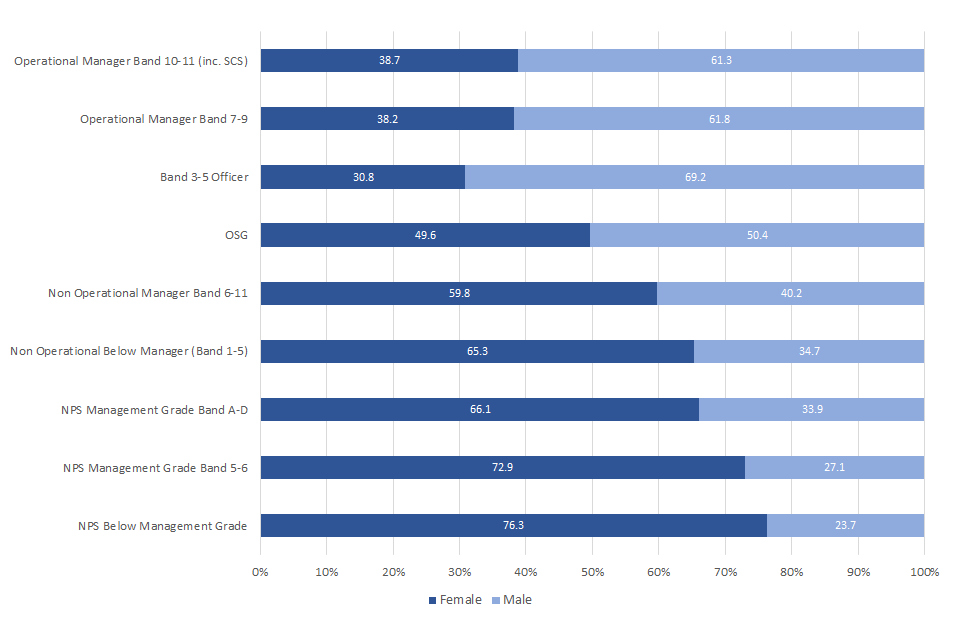
Across operational grades, there was a higher proportion of males compared to females. Senior leaders in public prisons and HMPPS HQ (Senior Civil Servants and operational managers including governors) were made up of 38.7% (86) of females. Furthermore, females accounted for 38.2% (342) of operational manager bands 7-9, 30.8% (7,085) of prison officer bands 3-5, and 49.6% (2,686) of Operational Support Grades (OSGs).
In contrast, there were more female than male staff in non-operational grades (in prisons, HMPPS HQ and Area Services); 59.8% in non-operational manager grades (an increase of 3.2 percentage points from 56.6% in March 2021), and 65.3% in non-operational grades below management level (up by 0.4 percentage points from 64.9% since the previous year) were female.
The Probation Service[footnote 1] had higher female representation than the other parts of HMPPS. Females predominated in the Probation Service at all levels, comprising of 66.1% (230) of staff in senior Probation roles (NPS bands A-D), 72.9% (1,414) in NPS bands 5-6, and 76.3% (12,829) in NPS grades below management level (which includes probation officers at band 4).
Figure 2: HMPPS staff by gender, age, and ethnicity, as at 31 March 2022
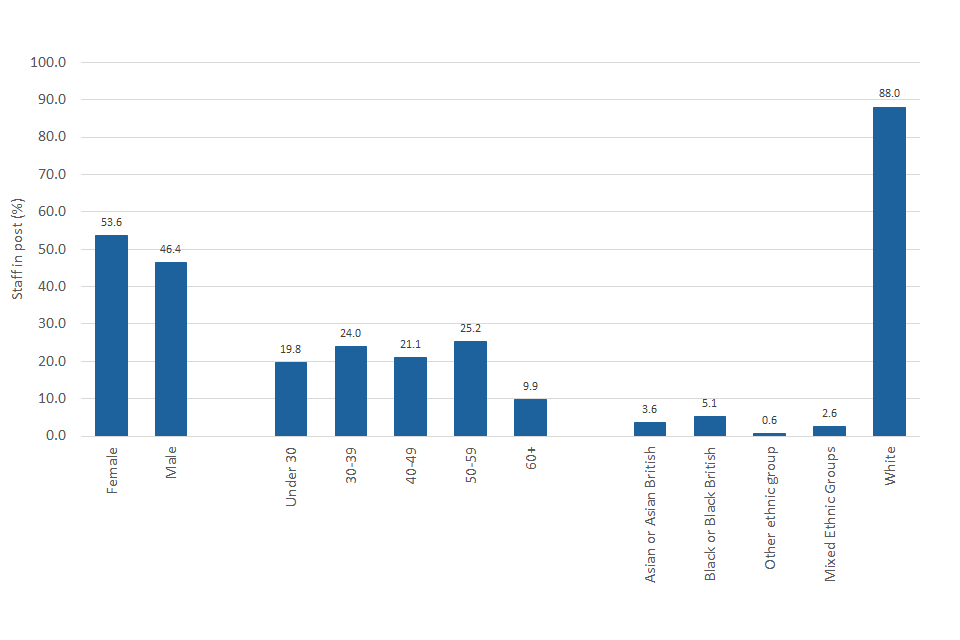
Age
As at 31 March 2022, the age band with the largest proportion of staff was those aged 50-59, comprising of 25.2% (15,644) of all staff. The proportion of those aged 40 or over as at 31 March 2022 stood at 56.2% (34,849), a decrease of 0.2 percentage points since the previous year whilst those aged under 30 represented 19.8% (12,265) of the HMPPS workforce, compared to 19.6% last year. The overall age distribution of HMPPS staff has remained consistent since March 2018.
Across all grades, the age bands with the highest proportion of staff were either the 40-49 or 50-59 age band, except for band 3-5 officers where a higher proportion of staff were aged between 30-39 (28.1% of staff aged 30-39). Moreover, just over a quarter (26.0%) of the band 3-5 officers in post as at 31 March 2022 were aged below 30.
Ethnicity
As at 31 March 2022, 83.4% of staff had declared their ethnicity. Of these, 12.0% (6,187) were ethnic minority. There were some differences between the groups within the ethnic minority group, with 5.1% of staff being from a black background compared to 0.6% of staff who declared as other ethnic. By grade, the lowest ethnic minority representation was for operational managers bands 7-9 at 5.7% (49), an increase of 0.2 percentage points compared to the previous year (5.5%).
Figure 3: HMPPS staff by disability status, religion, and sexual orientation, as at 31 March 2022

Disability
Overall, 76.2% of staff had declared their disability. Of those who had declared their disability, there were 15.4% of staff who declared themselves as disabled compared to 84.6% who declared themselves as non-disabled. The lowest disability representation rate was for band 3-5 officers at 9.8% (1,659), and the highest representation rate was for NPS below management grade at 22.3% (2,887).
Religion
Overall, 73.5% of staff had declared their religion. Of those who had declared their religion, 45.8% were Christian, 45.8% had no religion and 8.4% were non-Christian. There were some differences between the groups within the non-Christian Religion category, with most non-Christian staff being Muslim or Other at 2.5% and 3.7% respectively, compared to 0.2% of staff who declared as Jewish.
Sexual Orientation
Overall, 74.4% of staff had declared their sexual orientation. Of those who had declared their sexual orientation as at 31 March 2022, 93.1% were heterosexual/straight compared to 6.9% of staff declaring themselves as LGBT (Lesbian, Gay, Bisexual and Other).
2. Joiners
There were 8,158 (headcount) new recruits to HMPPS in 2021/22; 2,355 more than in 2020/21 and a 40.6% increase. Females accounted for 57.2% of joiners and more than half of joiners (55.7%) were aged under 30 years old.
The number of staff appointed to HMPPS increased from 5,803 in 2020/21 to 8,158 in 2021/22, a 40.6% increase. The largest group of recruits were band 3 to 5 officers, with 3,845 appointed in the 12 months to 31 March 2022. Figure 2 shows a breakdown of joiners across the available protected characteristics; additional details can also be found in the tables 2a and 2b.
Figure 4: HMPPS new joiners by protected characteristic, 1 April 2021 to 31 March 2022
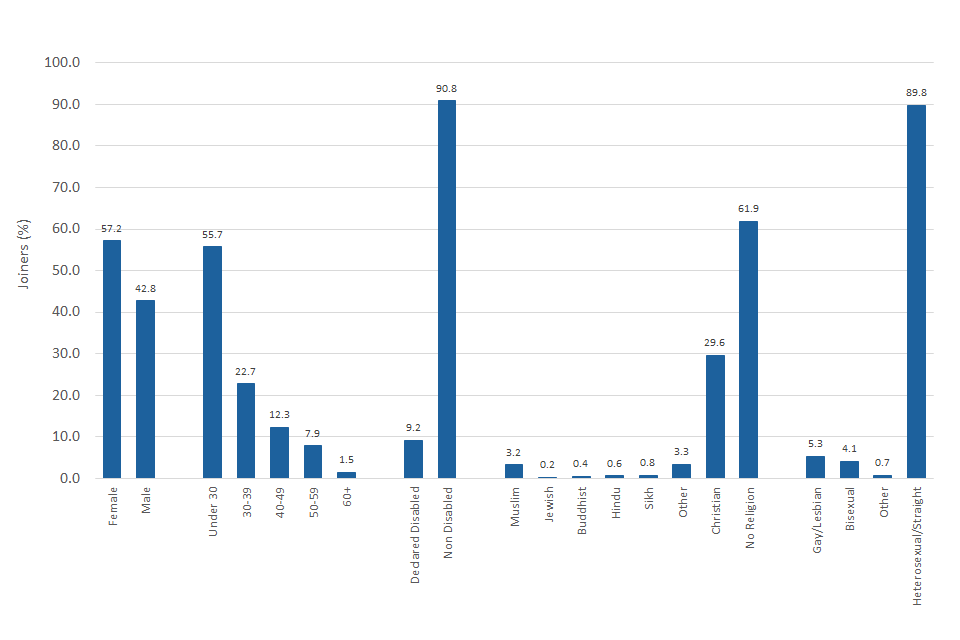
Note: Ethnicity breakdowns are not shown due to low declaration rates.
Overall, 42.8% of those who joined HMPPS were male and 57.2% were female. This varied by grade with most of the grades having new recruits who were largely female, such as Probation Service below management level (77.8%) and Probation Service management level (70.8%) grades. However, Band 3-5 officer recruits had a higher proportion of males (56.2%).
More than half of new joiners (55.7%, equivalent to 4,544 individuals) in 2021/22 were aged under 30 whilst 21.6% (1,762) were aged 40 or older. Specifically, 60.9% (2,340) of staff who joined as band 3-5 officers were aged under 30.
Declaration rates are high enough for disability, religion, and sexual orientation to allow meaningful analysis by these protected characteristics, however the declaration rate for ethnicity is still too low.
Of the 63.8% of joiners that declared their disability status in 2021/22, 9.2% were self-declared as being disabled compared to 90.8% of non-disabled staff. Where numbers were large enough to disclose, the lowest disability representation was for band 3-5 prison officers at 6.6% and the highest representation rate was for non-operational managers at 24.1%.
There was a higher proportion of joiners who declared themselves as having no religion (61.9%) compared to those belonging to a religious group (38.1%, of which 29.6% were Christian and 8.6% were non-Christian).
Of those who had declared their sexual orientation, a higher proportion of recruits were heterosexual/straight at 89.8% compared to 10.2% who were Lesbian, Gay, Bisexual and Other (LGBT). Of the LGBT categories, Gay/Lesbian staff made up the largest proportions of joiners at 5.3% compared to bisexual and ‘other’ (4.1% and 0.7% respectively).
3. Temporary Cover
As at 31 March 2022, 3,576 staff (6.4%) were receiving temporary cover allowances (TCA). TCA rates were higher for females, those aged 30-39 years old, mixed ethnicity staff, non-disabled staff, and non-religious staff.
Temporary cover payments are a system that enables staff to work temporarily in a more senior role and receive an additional payment while this work is undertaken. Although temporary cover payments tend to be received for a considerable duration while an individual covers a role at a higher grade on a temporary basis, these figures are based on snapshots at a moment of time at the end of a financial year. As such, they may not accurately represent the rates of those receiving cover payments during the financial year.
As at 31 March 2022, 3,576 staff were receiving Temporary Cover Allowances for filling posts of a higher grade on a temporary basis. This represents 6.4% of staff, a slight increase from 6.3% of staff as at 31 March 2021. The rate of temporary cover allowances is illustrated in figure 3, with additional details in tables 3a and 3b.
Figure 5: Temporary cover allowances (TCA) per 100 staff, as at 31 March 2022
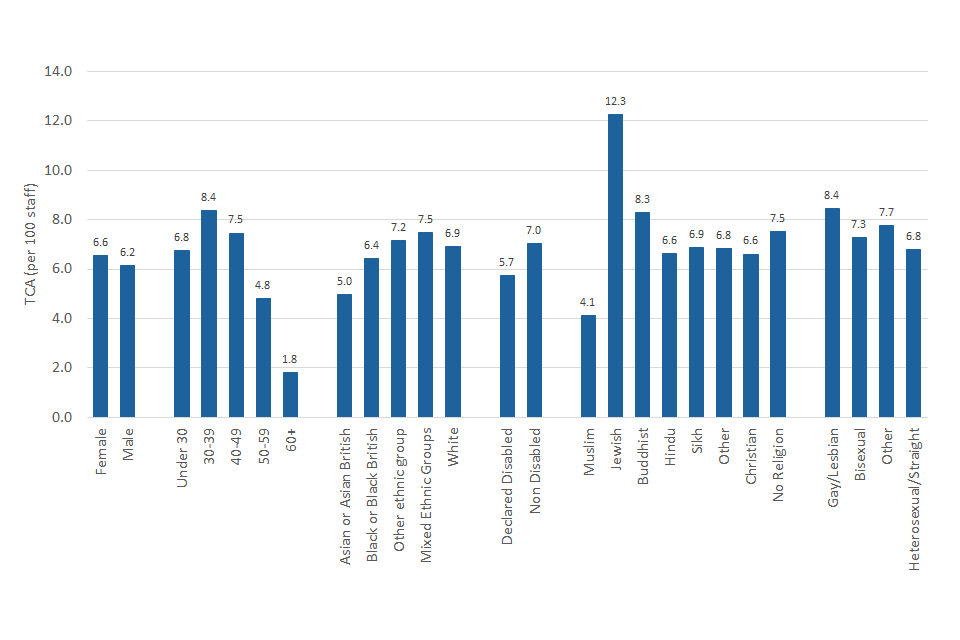
As at 31 March 2022, 6.6% of females were on temporary cover compared to 6.2% of males. For operational and non-operational staff, rates for TCA were lower for female managerial staff but higher for females in junior roles, such as band 3-5 officers and non-operational below manager grades. The TCA rates among female staff in probation service grades were higher than that for male staff.
Temporary cover payments were most prevalent amongst those aged 30 to 39 and 40 to 49 (8.4% and 7.5% respectively), compared to 6.8% of under 30s, 4.8% of staff aged 50 to 59 years old, and 1.8% of staff aged 60 or over.
As at 31 March 2022, 6.3% of ethnic minority staff were receiving temporary cover payments compared to 6.9% of white staff. Last year, 6.3% of ethnic minority staff and 6.7% of white staff were on temporary cover. Numbers within the ethnic minority subset groups were low, so some caution is advised when viewing rates. However, within the ethnic minority category, staff who declared as mixed ethnic groups had the highest rate of receiving TCAs at 7.5%.
The proportion of staff receiving temporary cover allowances was lower amongst disabled staff compared to non-disabled (5.7% and 7.0% respectively as at 31 March 2022).
As at 31 March 2022, 6.3% of non-Christian staff were receiving temporary cover payments, compared to 6.6% of Christian staff and 7.5% of staff with no religion. Within the non-Christian religion subset groups, staff who declared as Jewish had the highest rate of receiving TCAs at 12.3%. This figure should be treated with caution due to the small number of Jewish staff in post as 31 March 2022 (106).
The proportion of staff receiving temporary cover allowances was higher amongst staff who declared themselves as LGBT (lesbian, gay, bisexual, or other) at 8.0% compared to 6.8% of heterosexual staff.
4. Promotions
In 2021/22, 4.9% of permanent staff were promoted, an equivalent of 2,933 promotions. The rate of promotions was higher for: females, those aged 30-39 years old, mixed ethnic groups, non-disabled, non-religious staff and staff who identified as gay or lesbian.
Promotions relate to staff moving to a more senior grade through an internal process. Operational Support Grade staff who convert to become prison officers are known as ‘conversions’ and not defined as promotions and so this specific grade change does not appear in this report. Promotions are reported in terms of the grade of the staff prior to promotion rather than the grade they were promoted into. Similarly, rates are calculated in relation to the number of staff in the lower grade.
In 2021/22, 4.9% of staff were promoted (the equivalent of 2,933 promotions within the year), an increase from the rate of 3.8% (2,004 promotions) in 2020/21.
The rate of promotions, which represents the number of individuals promoted per 100 staff, in 2021/22 across all protected characteristics is illustrated in figure 4. Additional details on promotions can also be found in tables 4a and 4b.
Figure 6: Promotions per 100 staff, 1 April 2021 to 31 March 2022
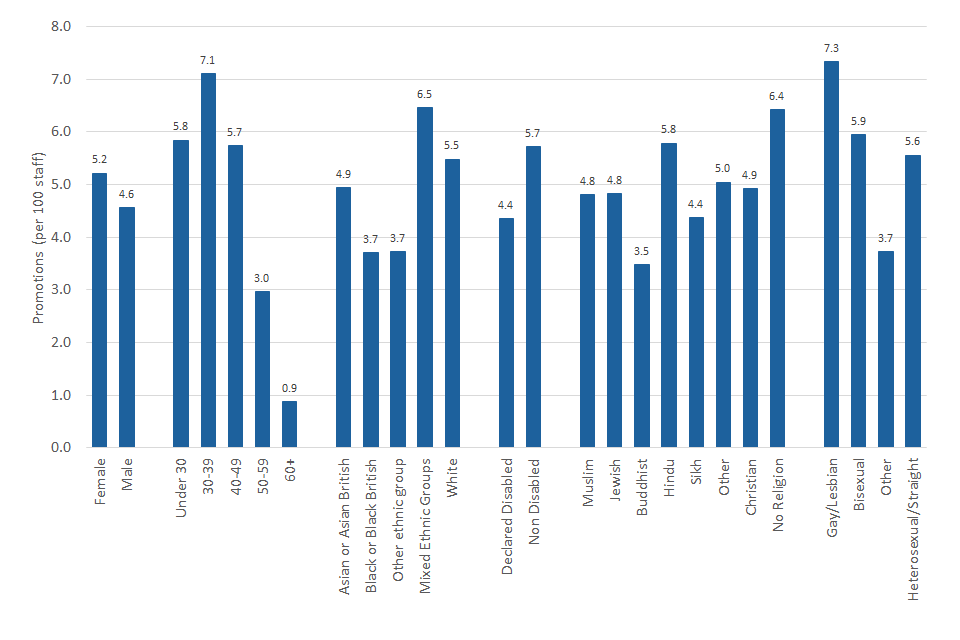
The promotion rate for female staff was higher in 2021/22 at 5.2% (1,636) than for males at 4.6% (1,297). Over the past 4 years, promotion rates have been consistently higher among female staff compared to male staff. This trend was also seen across all operational, non-operational and probation service grades in 2021/22.
The rate of promotions declines as the age of staff increases after the 30-39 age bracket. In 2021/22, staff aged under 30 had a promotion rate of 5.8% while staff aged 30 to 39 had the highest rate of promotion at 7.1% of staff in post, compared to 5.7% for staff aged 40 to 49, 3.0% for the 50-59 age group and 0.9% for staff aged 60 and over.
In the 12 months ending 31 March 2022, ethnic minority staff had a lower promotion rate at 4.7% than white staff at 5.5%. Within the ethnic minority groups, those identifying as mixed ethnicity had the highest rate at 6.5%.
In 2021/22, the rate of promotion between staff who declared themselves disabled was lower than that of non-disabled staff, at 4.4% and 5.7% respectively. This pattern was seen across all grades apart from operational managers, where the rate of promotion was 10.1% for staff who declared themselves as disabled compared to 8.0% of non-disabled staff. This figure should be treated with caution due to the relatively small number of operational managers in post.
In 2021/22, the promotion rate was the same amongst non-Christian staff and Christian staff (4.9%). These rates were lower compared to the promotion rates of those with no religion (6.4%).
Staff who identified themselves as LGBT (lesbian, gay, bisexual, or other) had a higher rate of promotion compared to heterosexual staff (6.6% and 5.6% respectively). Across grades (where figures are large enough to disclose), band 3-5 prison officers who identified themselves as LGBT had higher rates of promotion (7.5%) compared to heterosexual band 3-5 prison officers (6.3%). This was also the case for non-operational below manager grades (11.9% of LGBT, 7.9% heterosexual) and NPS below management grades (4.2% LGBT, 2.8% heterosexual).
5. Staff Appraisals
For the year 2021/22, the normal appraisal reporting was suspended due to the COVID-19 pandemic.
In HMPPS, the system of staff appraisals is called the ‘Staff Performance and Development Record’ (SPDR). There is an annual cycle of appraisals, and marks are awarded at the mid-year and then the end-year. It is the end-year markings that are shown within the data tables.
For the financial year 2019/20, the usual process for SPDR assessment at year end in HMPPS was suspended due to COVID-19, with the aim of relieving staff of some of the administrative burden around the end of year performance management process at a challenging time. Given the exceptional circumstances, managers were only required to record a rating for those staff assessed as ‘outstanding.’ This means that most staff would have been awarded with a ‘good’ marking, including those whose performance may have dipped to ‘improvement required.’ Therefore, for those two markings analysis and comparison with previous years are not possible. Staff on formal Managing Poor Performance measures were recorded separately and this process continued as usual.
For the financial years 2020/21 and 2021/22, the normal reporting process was suspended due to the challenges of managing the COVID-19 pandemic. Managers were not required to complete appraisal reports or input performance markings. As in 2019/20, staff on formal Managing Poor Performance measures were recorded separately and this process continued as usual.
As of April 2022, SPDR has been removed and replaced with a new performance management system that no longer requires a performance marking in SOP. Therefore, for 2022/23 onwards, staff appraisal data will no longer exist for HMPPS and will not be published in this report going forward. Poor performance measures will continue as previous years.
Further detail on appraisal ratings in previous years can be found in tables 5a.
6. Special Bonuses
The rate of special bonuses awarded to staff in 2021/22 was 6.0 per 100 staff. The rate of bonuses awarded was higher for; Males (at 6.7 per 100 staff) compared to their female counterparts (5.4 per 100 staff), ethnic minority staff (at 6.9 per 100 staff) compared to white staff (at 6.5 per 100 staff), and non-disabled staff (at 6.7 per 100 staff) compared to disabled staff (at 5.2 per 100 staff).
Special bonuses allow local management the opportunity to recognise and reward any member of staff for exceptional performance in a particularly demanding task or situation through a one-off non-consolidated lump sum payment of up to £2,000 (or up to £20,000 with CEO approval). Special bonuses can be rewarded in either cash or voucher form.
In 2020/21, a range of COVID-19 special payment schemes were set up for frontline prison and probation staff, to support them through the COVID-19 pandemic in recognition of the exceptional circumstances in which they were working. These special payment schemes were processed as special bonuses, and cannot be separated from special bonuses, which resulted in the 2020/21 bonus figures being much higher than those for other years. The figures show total bonus value awarded to staff in 2020/21 was £47.5m compared to £1.2m in 2019/20 and £1.9m in the latest year, 2021/22. As the 2020/21 data contains these extra COVID-19 special payments, please treat any comparisons to this year with caution.
The rate of special bonuses awarded to staff in 2021/22 was 6.0 per 100 staff, compared to 64.3 per 100 staff in 2020/21 (which included Covid-19 payments) and 3.6 per 100 staff in 2019/20 which was before COVID-19 payments were given. The average value of the awards per staff member was £533 in 2021/22 which is decrease from previous years.
Across the grades, the rate of bonuses awarded was higher for managerial positions than for junior positions. In operational grades, operational managers were awarded bonuses at a rate of 34.0 per 100 staff compared to the more junior operational positions of band 3-5 officers at 7.2 per 100 staff, and OSGs at 2.3 per 100 staff. A similar pattern was seen for non-operational and NPS grades too; non-operational managers were awarded bonuses at 24.6 per 100 staff compared to more junior non-operational positions at 4.2 per 100 staff, and NPS management grades were awarded bonuses at 9.0 per 100 staff compared to NPS below management grades at 1.1 per 100 staff.
The average value per award across protected characteristics are illustrated in figures 5 below, and bonus statistics can be viewed in tables 6a, 6b(i) and 6b(ii).
Figure 7: Special bonuses awarded per 100 staff, 1 April 2021 to 31 March 2022

Figure 8: Average value of special bonuses awarded, 1 April 2021 to 31 March 2022

The rate of special bonuses awarded in 2021/22 was higher for males at 6.7 per 100 staff than for females at 5.4 per 100 staff. The average value of the bonuses was higher for females who received an average of £538 compared to males who received an average of £529. The rate of special bonuses awarded was higher for males than females across all grades except OSGs, non-operational roles (both managers and junior positions) and NPS below management grades.
In 2021/22, staff in the 40-49 age group had the highest rate of bonuses awarded at 7.4 per 100 staff, and the average value of bonuses for this age group was the second highest compared to the other age groups at £591. Staff aged 50-59 had the highest average value of awards at £646.
In 2021/22, the rate of bonuses awarded to ethnic minority staff was higher compared to white staff (6.9 compared to 6.5 per 100 staff respectively), but the average value of bonuses awarded was lower with an average of £513 for ethnic minority staff and £549 for white staff. There were differences between the rates and average value of bonuses awarded to the different groups of ethnic minority staff. Staff who declared themselves as ‘other ethnic groups’ were awarded the highest bonuses at a rate of 8.1 per 100 staff, with an average value of £569. In contrast, staff who declared themselves as black or black British were awarded the lowest bonuses at a rate of 6.4 per 100 staff. Staff from an Asian or Asian British background were awarded the least, with an average value of bonuses of £448.
The rate of bonuses awarded in 2021/22 to those who declared as disabled was 5.2 per 100 staff, compared to 6.7 per 100 staff for non-disabled staff. The average value of these awards was slightly higher for those declared disabled at £551, compared to non-disabled at £547.
In 2021/22, the rate of bonuses awarded to those who declared as being affiliated with non-Christian religions (7.1 per 100 staff) was higher compared to those who declared as Christian (6.7 per 100 staff) and those with no religion (6.6 per 100 staff). Staff who declared themselves as LGBT (Lesbian, Gay, Bisexual and Other) were awarded bonuses at a higher rate than heterosexual staff (7.6 per 100 staff compared to 6.5 per 100 staff). However, LGBT staff were awarded a lower average value of the awards (£468) compared to heterosexual/straight staff (£551).
7. Grievances
In 2021/22, 981 staff raised grievances resulting in 1,140 cases. Of these cases, 39.6% were upheld/partially upheld. This is an increase from 2020/21 where 752 staff raised grievances resulting in 897 cases. The raising of grievances in 2021/22 was higher for: ethnic minority staff (at 2.5 per 100 staff) compared to White staff (at 1.5 per 100 staff) and disabled staff (at 3.3 per 100 staff) compared to non-disabled staff (at 1.4 per 100 staff).
A grievance is defined as any concern, problem or complaint raised by an individual member of staff relating to his or her employment. Only grievances that have gone through the formal procedure are analysed here. Grievances resolved locally or through mediation are not recorded centrally. Further details on grievances can be found in tables 7a, 7b(i) and 7b(ii).
In 2021/22, there were 981 staff who raised grievances, resulting in 1,140 cases. Of these cases, 39.6% (451 cases) were upheld or partially upheld, a decrease of 2.6 percentage points compared to the previous year. The overall figure for the number of grievances raised in 2021/22 represented 1.6 per 100 staff, an increase from 2020/21 (1.4 per 100 staff). Across grade breakdowns, band 3-5 prison officers had the highest rate in terms of raising a grievance at 2.1 per 100 staff.
Figures 9 and 10 show the rate per 100 staff raising grievances and the percent of cases upheld or partially upheld, split by protected characteristic.
Figure 9: Number of staff per 100 staff raising grievances, 1 April 2021 to 31 March 2022
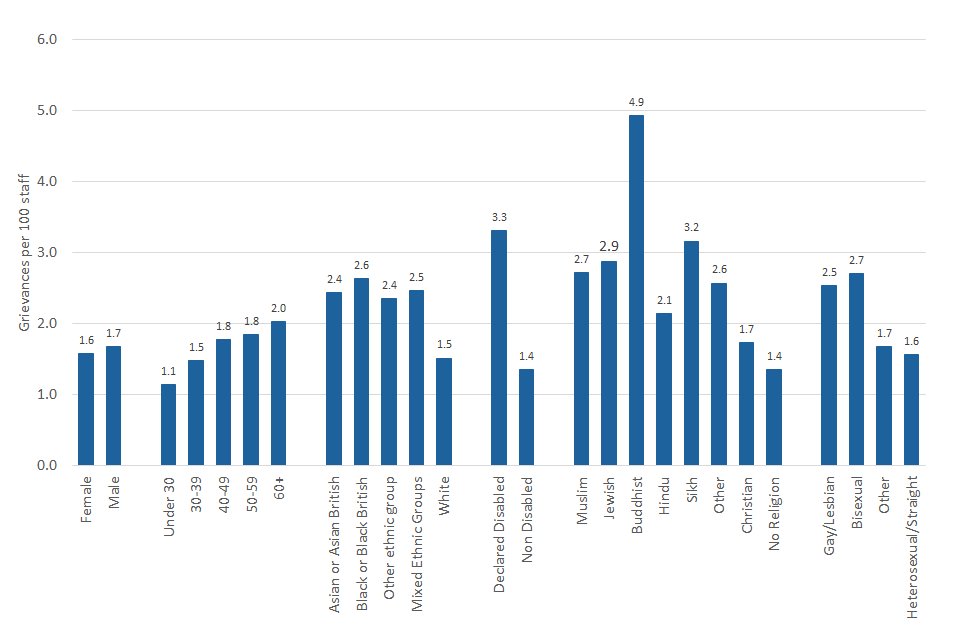
Figure 10: Percent of cases upheld or partially upheld, 1 April 2021 to 31 March 2022
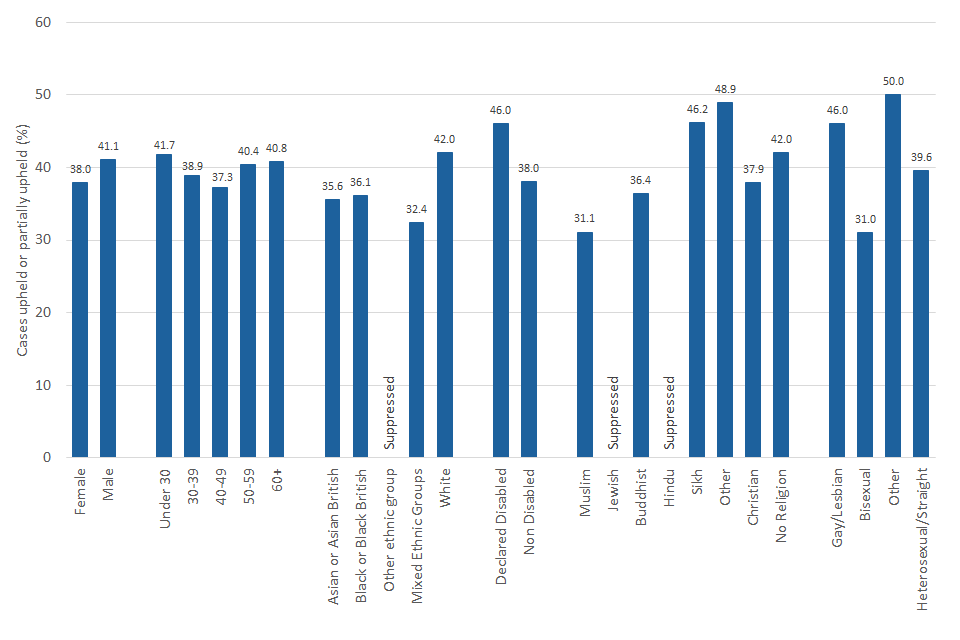
Overall, female staff raised grievances in 2021/22 at a slightly lower rate than males, at 1.6 and 1.7 per 100 staff, respectively. Across grades, females raised fewer grievances per 100 staff compared to males in Probation Service grades (both manager and junior grades), but not in operational grades (operational managers, band 3-5 officers, OSGs) and non-operational grades (non-operational manager and non-operational below management grades), where female staff raised a higher rate of grievances than male staff. The largest difference between rates of female and male staff who a raised grievance was for both the operational manger grade group (at 2.3 and 1.7 per 100 staff respectively) and the non-operational manager grade group (at 1.2 and 0.6 per 100 staff respectively). The percentage of cases upheld or partially upheld in 2021/22 was lower for females (38.0%) than for males (41.1%).
In 2021/22, there was a tendency for the rate of grievances to increase with age. Staff under 30 had a grievance rate of 1.1 per 100 staff compared to 2.0 per 100 staff aged 60 and over.
The overall rate of grievances raised per 100 staff was higher amongst ethnic minority staff compared to white staff, at 2.5 per 100 and 1.5 per 100 staff, respectively. The percentage of cases upheld or partially upheld was higher for white staff at 42.0% compared to staff from an ethnic minority background at 33.7%.
Overall, self-declared disabled staff raised more grievances, at a rate of 3.3 per 100 staff, than non-disabled staff, at 1.4 per 100 staff. Considering grades where numbers are large enough to disclose, this pattern was seen across all grades.
Non-Christian staff raised more grievances than Christian staff, at 2.8 and 1.7 per 100 staff, respectively. Of the non-Christian staff, the rate of grievances raised was highest for Buddhist staff at 4.9 per 100 staff. Considering grades where numbers are large enough to disclose, this pattern was seen across all grades except for OSGs where the rate was the same at 1.8 per 100 staff. Christian staff had a lower proportion of cases being upheld or partially upheld at 37.9% compared to non-Christian staff at 40.8%.
Staff who identified themselves as LGBT raised more grievances, at a rate of 2.5 per 100 staff, compared to heterosexual staff, as at a rate of 1.6 per 100 staff. The percentage of cases upheld or partially upheld was lower for heterosexual staff at 39.6% compared to LGBT staff at 41.2%.
8. Investigations and Conduct & Discipline cases
In 2021/22, the overall rate of investigated staff was 2.8 per 100 staff, a decrease from 3.4 per 100 staff in 2020/21 The rate was higher amongst; male staff (4.2 per 100 males) compared to female staff (1.6 per 100 females), Black, Asian and minority ethnic staff (3.2 per 100 staff) compared to White staff (2.8 per 100 staff), and those under 30 (3.7 per 100 staff) compared to staff in other age bands.
In 2021/22, the overall rate of conduct and discipline cases was 1.2 per 100 staff, a decrease from 1.5 per 100 staff in 2020/21 The rate was three times higher for male staff (1.8 per 100 male staff) compared to female staff (0.6 per 100 female staff). Black, Asian and minority ethnic staff and White staff had the same rate of conduct & discipline cases (1.2 per 100 staff).
Investigations into staff conduct are designed to establish the truth of the case and to determine whether conduct and discipline action is recommended. A conduct and discipline case imposes a penalty on a member of staff for wrongdoing. In cases of summary dismissal, it is not always possible to have had a full internal investigation.
Both investigations and conduct and discipline cases may involve multiple charges and may have multiple outcomes for the different parts of the case. More than one member of staff can also be charged and penalised in a single case. For the purpose of this report, a case is defined as a charge or set of charges being brought against an individual. Where more than one individual is charged together, they are counted as multiple cases in this report.
Further details on investigations and conduct and discipline cases can be found in tables 8a, 8b(i) and 8b(ii), and 9a, 9b(i) and 9b(ii).
In 2021/22, 1,704 staff faced at least one investigation, representing a rate of 2.8 investigated staff per 100 staff, a decrease from 3.4 investigated staff per 100 for 2021/22. Of the 1,704 cases, 1,152 (63.3%) had further action recommended. In 2021/22, band 3-5 officers had a higher rate of investigations than staff in other grades (5.5 investigated staff per 100 staff, with all other grades with a rate of 2.9 or below).
Overall, male staff were investigated at more than double the rate of female staff in 2021/22, at 4.2 investigated staff per 100 males compared to 1.6 investigated staff per 100 females. The rate of investigations for male staff was higher across all grades except for NPS management grade where the rates were the same (0.5 per 100 staff). The percentage of cases with further action recommended was also higher for males at 65.3% compared to 58.4% for males.
Figures 11 and 12 show the rates per 100 staff who were investigated in 2021/22 and the proportion of cases where further action was recommended, split by protected characteristic.
Figure 11: Staff subject to at least one investigation per 100 staff in post, 1 April 2021 to 31 March 2022
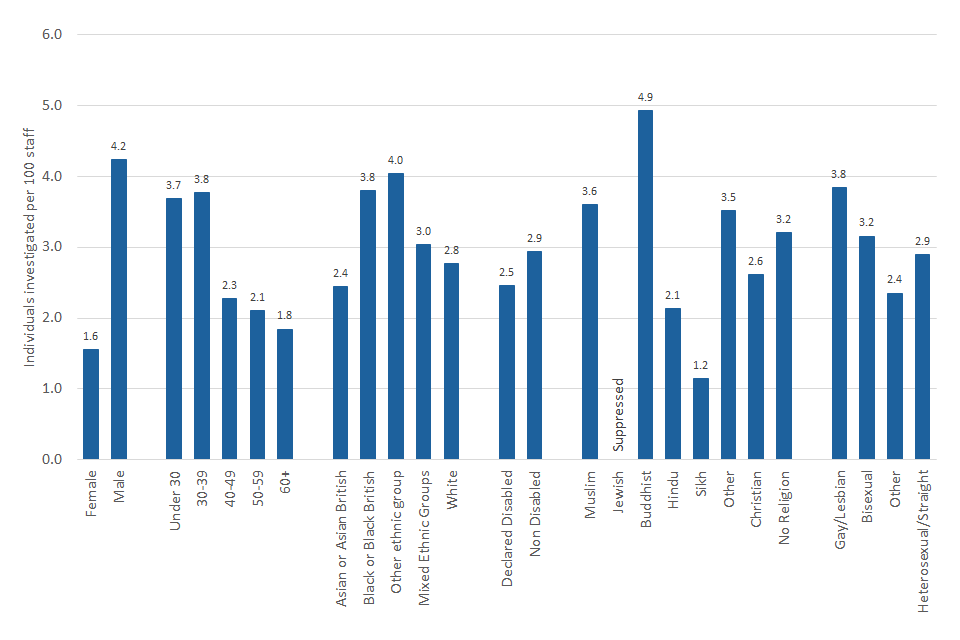
Figure 12: Proportion of Investigations where further action was recommended, 1 April 2021 to 31 March 2022
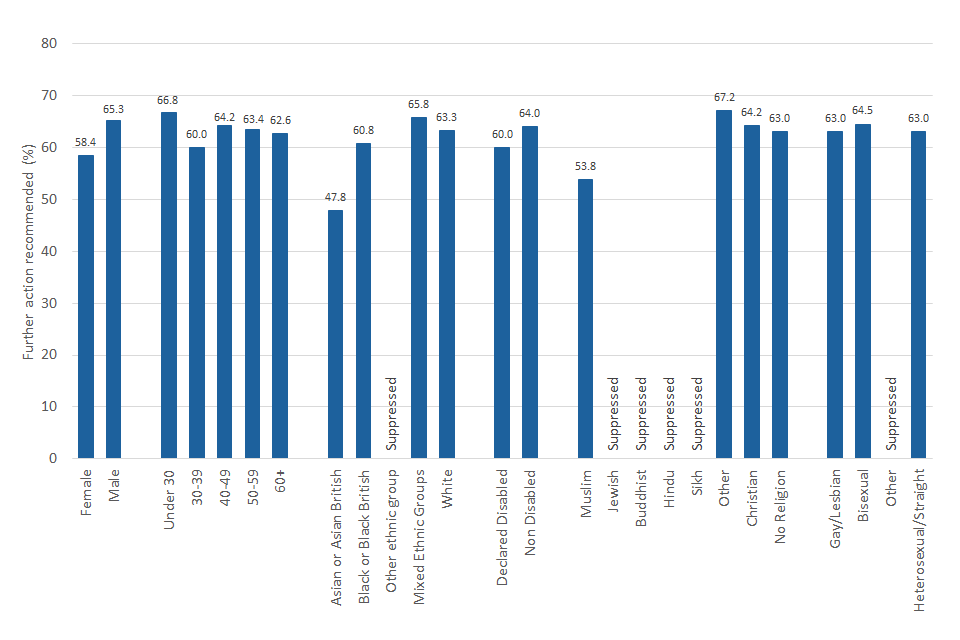
In 2021/22, there was a tendency for the rate of investigations to decrease with age from 3.7 investigated staff per 100 staff for those aged under 30, to 1.8 investigated staff per 100 staff aged 60 and over.
The proportion of ethnic minority staff investigated in 2021/22 was higher than the proportion of white staff investigated, 3.2 investigated staff per 100 staff compared to 2.8 investigated staff per 100 staff. The percentage of cases with further action recommended was lower for ethnic minority staff (59.0%) than for white staff (63.3%).
In 2021/22, the proportion of staff with non-Christian religious beliefs investigated was higher than for Christian staff, at 3.2 per 100 staff compared to 2.6 per 100 staff, respectively. Non-Christian staff had a lower proportion of cases with further action recommended (59.5%) compared to Christian staff or those with no religion (64.2% and 63.0% respectively).
There were 707 staff subject to conduct and discipline action in 2021/22, a rate of 1.2 per 100 staff. There was a total of 735 conduct cases and of these 19.7% resulted in the penalty of dismissal[footnote 2]. The rate of conduct cases was highest amongst band 3-5 prison officers at 2.2 per 100 staff.
Figures 13 and 14 show the rates per 100 staff who were subject to conduct and discipline action and the proportions of conduct cases leading to dismissal in 2021/22, split by protected characteristics.
Figure 13: Staff per 100 staff subject to conduct and discipline action, 1 April 2021 to 31 March 2022

Figure 14: Percentage of conduct cases leading to dismissal, 1 April 2021 to 31 March 2022
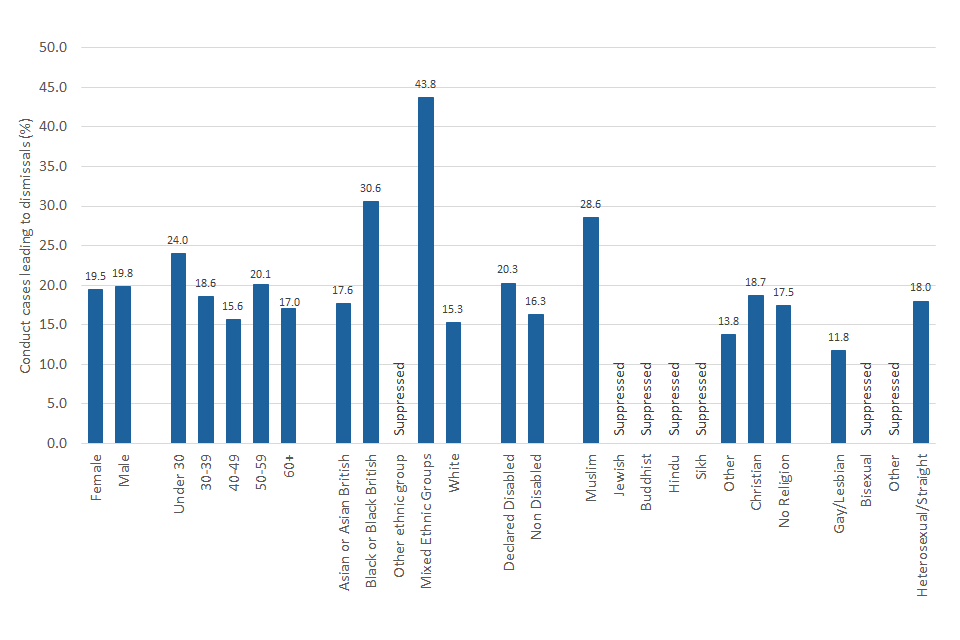
The rate of conduct cases involving male staff was three times the rate for female staff, 1.8 per 100 male staff compared to 0.6 per 100 female staff. The proportions of cases resulting in dismissal were slightly higher for male staff compared to female staff (19.8% and 19.5% respectively).
In 2021/22, the rate of conduct and discipline cases was highest among staff aged under 30 at 1.6 per 100 staff and decreased with age where those aged 60 and over had a rate of 0.8 per 100 staff.
In 2021/22, ethnic minority staff and white staff had the same rate of staff subject to conduct and discipline action per 100 staff with 1.2 per 100 staff, respectively. The percentage of dismissals resulting from conduct cases was higher for ethnic minority staff at 30.1% compared to white staff at 15.3%.
There was a similar proportion of staff subject to conduct and discipline among those who declared themselves as disabled, 1.1 per 100 staff, and non-disabled staff, 1.2 per 100 staff. The percentage of cases resulting in dismissals was higher for disabled staff compared to non-disabled staff (20.3% and 16.3% respectively).
In 2021/22, staff with non-Christian religious beliefs, 1.4 per 100 staff, were subject to conduct and discipline action at a higher rate than Christian staff, 1.1 per 100 staff. Non-Christian staff had a lower proportion of cases which resulted in dismissals (15.4%) compared to Christian staff (18.7%) or those with no religion (17.5%).
The rate of conduct and discipline cases was higher for staff who identified as LGBT compared to Heterosexual staff (1.6 per 100 staff and 1.2 per 100 staff respectively).
9. Sickness Absence
In 2021/22, HMPPS staff lost an average of 13.8 working days due to sickness, an increase of 2.4 average working days lost compared to 2020/21. The average working days lost due to sickness increased with age and was higher for males, and those that declared themselves as ethnic minority, disabled, non-Christian, or LGBTT.
Sickness absence is represented in this section by the average working days lost (AWDL) due to sickness per employee per year. Comparisons to the figures for the period 1 April 2017 to 31 March 2018 should be interpreted with caution due to an under-recording of sickness absence records during migration of data to the Single Operating Platform. To note, figures relating to the effect of COVID-19 on HMPPS staff have been included from 2019/20 in this publication. For further information on sickness reason, please see our HMPPS workforce release.
In 2021/22, the AWDL due to sickness absence was 13.8, an increase of 2.4 average workings days lost from 11.4 in 2020/21. The average working days lost to sickness absence was higher for male staff at 14.3 days, than for female staff at 13.3 days. This was seen across all managerial grades (Operational, non-operational and NPS), whereas the AWDL was higher for female officers, OSGS and NPS below management staff.
Figure 15 illustrates the AWDL in 2021/22 across all protected characteristics. Further details on sickness absence can be found in tables 10a and 10b.
Figure 15: Average working days lost due to sickness absence, 1 April 2021 to 31 March 2022

In 2021/22, the average working days lost to sickness absence generally increased with age from 12.2 days for those aged under 30 to 17.0 days for those aged the over 60s. This pattern was seen across many of the grades, except for band 3-5 officers and OSGs (where those aged 50-59 had the highest AWDL at 18.1 and 16.6 days, respectively).
In 2021/22, across operational, non-operational and NPS roles the AWDL was lower for senior staff compared to grades below management level. Operational, Non-Operational and NPS grades below management level had the highest levels of AWDL; 16.5 days for officers, 14.4 days for OSGs, 11.6 days for non-operational below manager and 13.5 days for NPS staff below management grade.
In 2021/22, the AWDL was 15.7 days for ethnic minority staff and 13.3 days for white staff. There were some differences in the AWDL between the groups within the ethnic minority group, with ‘other ethnic group’ having the highest rate of 18.5 days, followed by black or black British staff at 15.7 days, Asian or Asian British staff at 15.5 and mixed ethnic staff at 15.4. Compared to 2020/21, there was an increase in the AWDL among white staff of 2.3 days and an increase for all ethnic minority groups (excluding white minorities) of 2.8 days. By grade, in the 12 months ending 31 March 2022, the AWDL rate was higher for ethnic minority staff in all staff positions, apart from Operational managers (9.1 AWDL for white staff compared to 6.2 for ethnic minority staff) and Non-operational managers (5.8 AWDL for white staff compared to 5.1 for ethnic minority staff).
For 2021/22, those who declared themselves as being disabled had more working days lost, on average, than that of non-disabled staff, at 21.0 days compared to 12.0 days, respectively. Disabled staff had a higher AWDL compared to non-disabled staff across all grade groups where the declaration rates were above the 60% threshold.
In 2021/22, staff who declared themselves as being a non-Christian had a higher rate of AWDL of 16.1 days compared to Christian staff (13.6 days) and staff with no religion (12.6 days). Of the non-Christian religions, Sikh staff had the highest AWDL of 18.2 days. Staff who declared themselves as LGBTT had the highest rate of AWDL of 15.2 days compared to an AWDL of 13.3 days in heterosexual/straight staff.
10. Leavers
In 2021/22, the leaving rate of HMPPS staff was 12.6%, an increase of 4.2 percentage point since 2020/21.
Leaving rates were higher amongst male staff (13.2%) compared female staff (12.0%). By age, the highest leaving rate was for those aged under 30 (20.5%), followed by those aged 60 and over (19.6%).
In the 12 months ending 31 March 2022, 7,520 permanent staff (headcount) left HMPPS. The leaving rate stood at 12.6%, representing an increase of 4.2 percentage point from the previous year’s rate of 8.3%. For the 12 months to 31 March 2021, the increased uncertainty in the employment market following the COVID-19 pandemic may have contributed to the drop in the number of resignations during most of the year, therefore impacting on the overall reduced leaving rates. The latest leaving rates are now higher than pre-pandemic levels and are continuing the upward trend seen from pre-March 2020. The rates presented include retirement but exclude voluntary exits under the Voluntary Early Departure Scheme and redundancies (VEDSR).
Leaving rates for each protected characteristic are shown in figure 13. Further details on leavers can be found in tables 11a to 11c.
Figure 16: Permanent staff leaving rates (excluding VEDSR), 1 April 2021 to 31 March 2022
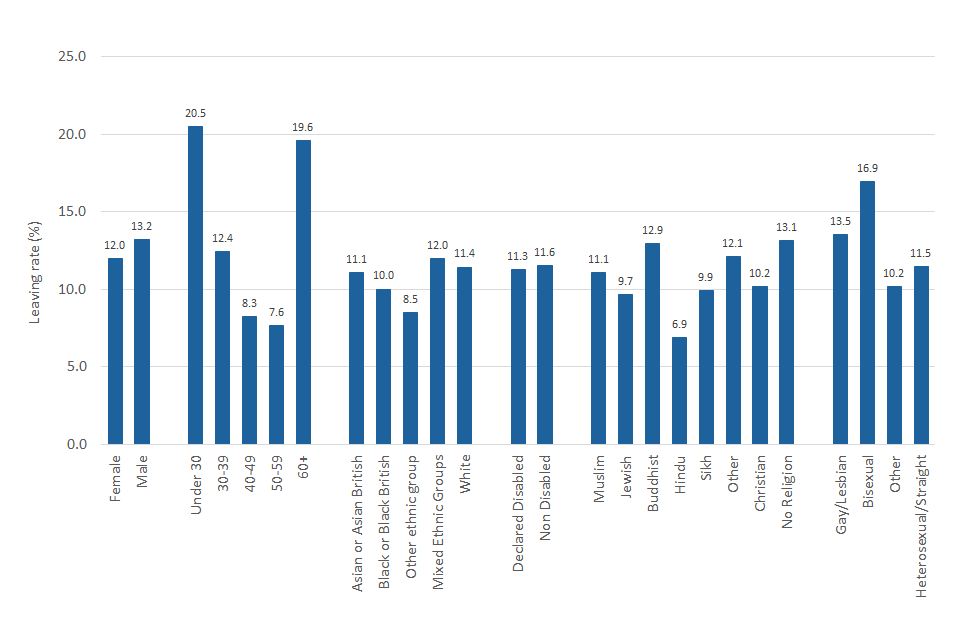
The leaving rate for female staff was lower in the 12 months ending 31 March 2022 at 12.0% than the rate for male staff at 13.2%, an increase of 4.1 and 4.4 percentage points respectively compared to the previous year.
Considering gender splits of leaving rates by grade group, in 2021/22, operational below management grades had the largest leaving rates; OSGs had a leaving rate of 18.3%, an increase from 11.9% in 2020/21, and band 3-5 officers had a leaving rate of 14.5%, an increase from 9.1% in 2019/20. Band 3-5 prison officers was the only grade where females had a higher leaving rate than males; a rate of 15.4% compared to 14.2%, respectively for band 3-5 officers.
As leaving rates include retirement it would be expected that those aged 60 and over would have one of the highest leaving rates. Accordingly, the leaving rate for those aged 60 and over was the second highest at 19.6% in the 12 months to 31 March 2022, an increase of 3.0 percentage points compared to the previous 12 months. Those aged under 30 had the highest leaving rates of 20.5%, which was an increase of 7.8 percentage points compared to the 12 months to 31 March 2021.
In 2021/22, the leaving rate was lower for ethnic minority staff at 10.7%, compared to white staff at 11.4%. Within the ethnic minority subgroups, those who declared themselves as mixed ethnic groups had the highest leaving rates at 12.0%. Staff who had declared themselves as disabled had a leaving rate of 11.3% which was higher than the leaving rate of non-disabled staff at 11.6%.
Declaration rates for religion and sexual orientation are above the level at which meaningful consideration can be made. In 2021/22, staff who declared themselves as having no religion had a higher leaving rate of 13.1% compared to non-Christian staff (11.2%) and Christian staff (10.2%). Staff who declared themselves as LGBT had a higher leaving rate of 14.2% than heterosexual/straight staff leaving rate of 11.5%.
Further Information
Accompanying files
As well as this report, the following products are published as part of this release:
-
A technical guide and glossary providing details of the data sources and quality. Information on the revisions policy and disclosure relevant to HMPPS staffing data as well as a definition of terms used is also included.
-
A set of tables for the year as well as over time.
Official Statistics
The statistics in this bulletin are classified as official statistics. The Statistics and Registration Service Act 2007 defines ‘official statistics’ as all those statistical outputs produced by the UK Statistics Authority’s executive office (the Office for National Statistics), by central Government departments and agencies, by the devolved administrations in Northern Ireland, Scotland, and Wales, and by other Crown bodies (over 200 bodies in total). The statistics in this bulletin comply with all aspects of the Code of Practice for Official Statistics. The Code encourages and supports producers of statistics to maintain their independence and to ensure adequate resourcing for statistical production. It helps producers and users of statistics by setting out the necessary principles and practices to produce statistics that are trustworthy, high quality and of public value.
Contact
Press enquiries should be directed to the Ministry of Justice press office:
Tel: 020 3334 3536
Email: newsdesk@justice.gov.uk
Other enquiries about these statistics should be directed to:
Bryce Millard
Workforce Statistics & Analysis
Data and Evidence as a Service (DES)
Ministry of Justice
10 South Colonnade
London
E14 4PH
Email: statistics.enquiries@justice.gov.uk
Next update: 23 November 2023
URL: www.gov.uk/government/collections/national-offender-management-service-workforce-statistics
© Crown copyright
Produced by the Ministry of Justice
Alternative formats are available on request from statistics.enquiries@justice.gov.uk
-
In this report, Probation Service staff are reported according to grade and therefore vary slightly from the total number of staff in the Probation Service. This is due to the small number of Probation Service staff in non-Probation Service grades. ↩
-
Details of appeals are not included in the analysis so several the penalties may have been overturned on appeal. ↩
